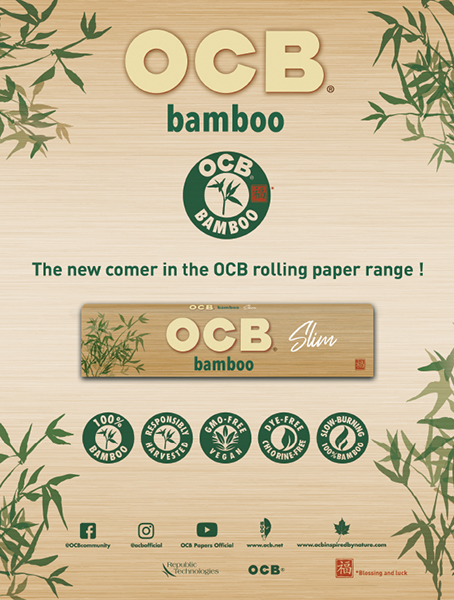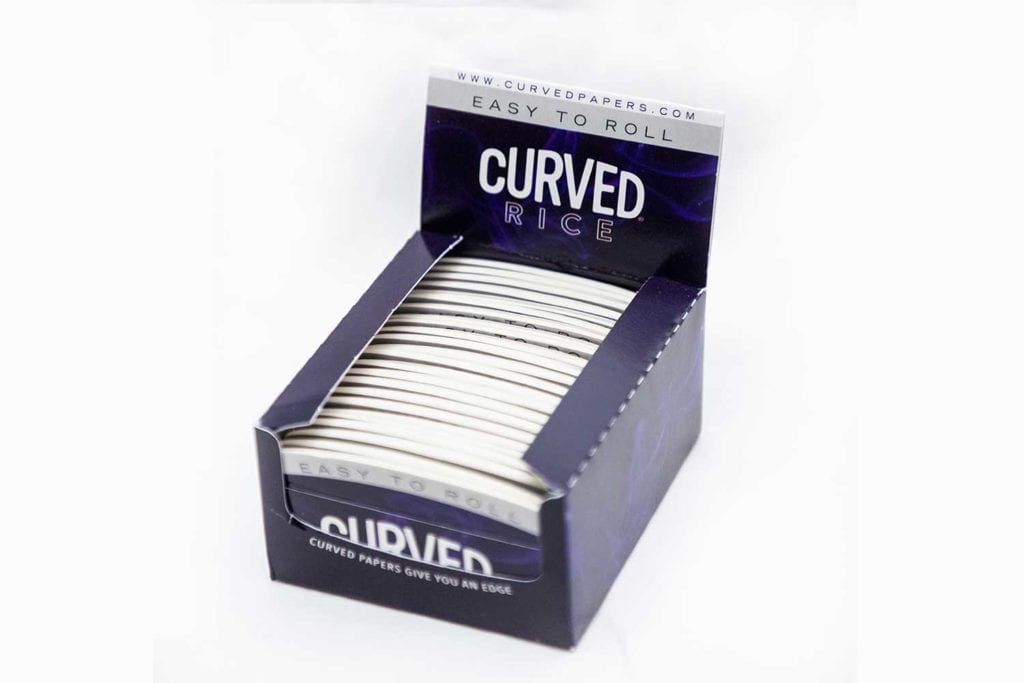
The Covid-19 pandemic notwithstanding, rolling papers, blunt wraps and cones are flying off the shelves in some markets.
By George Gay

If you speak about the roll-your-own (RYO) sector with Michael O’Malley of Curved Papers, much of what he says revolves around marijuana, so it is easy to come away with the idea that RYO’s future lies in this direction. But he dismisses this idea, pointing to the huge disparity in volume sales between those of tobacco and those of marijuana, which, of course, favors the former. However, he concedes that, right now, marijuana is making the news and the running, partly by providing what he describes as a “vortex of innovation.”
I guess this is only to be expected. Tobacco has been on sale legally for a long time while marijuana is only now gaining the stamp of legislative approval in a limited number of jurisdictions. This is the time for marijuana-use research and fast-moving, follow-up innovation, something that has attracted the attention of a wide range of companies, including major corporations involved with tobacco, beverages and consumer packaged goods: companies that are investing directly or indirectly in marijuana and associated intellectual property.
Overall, the RYO market was steady globally, said O’Malley, but, at the same, it was generating a significant expansion in brands and products because of the entry of marijuana, primarily in North America. In 2017, Canada and Mexico both passed federal legislation on marijuana and, recently, Mexico followed through with full adult use (previously more usually termed “recreational use” to distinguish it from medicinal use), leaving the U.S., by far the largest market, the laggard on federal legislation. However, 17 U.S. states, including some populous ones, had now opted for full legalization while almost every state had a legal medical marijuana program.
That last point is significant because the dynamics of U.S. state legalization has tended to see medicinal marijuana leading the way before being followed by adult use. In some states that allowed only medicinal use, programs were based on “no flower consumption”—that is, no smoking. However, under pressure from people making use of these programs, and with the support of medical professionals, new regulations and/or legislative amendments have been introduced to allow for smoking to be part of these programs.
O’Malley, who is based in the U.S., believes the legalization of marijuana will sweep from state to state and will eventually lead the U.S. to align nationally on this issue and broadly with its North American neighbors, despite the existence of considerable resistance in some states and powerful opposition at the federal level.

Flying off the shelves
Even with the situation as it is, O’Malley was moved to say that now was something of a “golden age” for the RYO market, encompassing both tobacco and marijuana. Rolling papers, blunt wraps and cones were all flying off the shelves like never before, he said, notwithstanding the Covid-19 pandemic. In part, this was because, in the U.S., outlets selling RYO products, including convenience stores, gas stations and dispensaries, were largely deemed essential at the outset of the pandemic while smoke shops and head shops had also been open for some time.
At the time of writing in mid-April, Curved Papers had suffered no supply chain interruptions because of the pandemic and, as a consequence, had been able to absorb an uptick in demand for its products. O’Malley said the legalization of marijuana was attracting new smokers and that many of these were drawn to Curved Papers’ products because their curved edge made it easier to roll a cigarette with inexperienced fingers. At the same time, he added, expert rollers continued to enjoy the “elegant convenience of the easy-to-roll curved edge.” And he is confident about the future, saying that economics and consumer preferences would remain favorable for hand-rolling.
This confidence is steadfast even in the light of the emergence of machines capable of producing cylindrical joints resembling tobacco cigarettes. In fact, O’Malley sees the products of these new machines, some of which are expected to be launched this year, as providing competition more for the products of the knockbox machines used for filling cones than for hand-rolled cigarettes. “These new machines will not eliminate rolling joints,” he said. “We see them as complementary to and supportive of our markets.” Smoking the flower had survived the onslaught of speculative product introductions in the past, he added, including that of vaping devices.

Ancillary products
While recent developments have seen the introduction of a lot of new products and product categories, O’Malley points out that rolling papers still comprise the biggest of the ancillary products in both tobacco and marijuana. But this should not be interpreted as meaning that O’Malley is anti-new developments or anti-technology. He describes Curved Papers as being an innovative company with a soon-to-be-announced development that will have an impact on how rolling papers are made in the future.
For the time being, however, the company is content to remain a supplier of an ancillary product that doesn’t become involved directly with marijuana plants and therefore doesn’t become tied up with the accompanying regulations.
However, it has consulted with companies that are so involved, including those researching CBD rolling papers and marijuana wraps. And, O’Malley said, because sustainability was a core value for Curved Papers, it had collaborated in the field of so-called hemp plastic, from which it would like to see produced a truly recyclable “doob tube,” which, for the uninitiated such as me, is a container in which to keep pre-rolled joints.
Finally, O’Malley mentioned that while it was difficult to predict how U.S. relations with China would develop, there were likely to be implications for the RYO sector. China-made rolling papers had fueled a previously unseen white label market that had undercut European suppliers on price and that was continuing to narrow the gap on quality. But that surge might be slowed if East-West relations chilled during the next decade, and it was possible that the positions taken by the U.S. and the EU on China might differ, leaving the U.S. more isolated. In that case, he said, it would be interesting to see if product manufacturing returned to the U.S., even in the case of ancillary products such as tobacco rolling papers. “We see a possible window opening, again aided by developments around marijuana,” he said.

Environmental considerations

For the time being in Europe, one of the main concerns of the RYO sector is the EU’s Single-use Plastics (SUP) directive, which Santiago Sanchez of Republic Technologies International (RTI) described as almost surreal. He said he agreed that the use of plastics should be restricted because the damage being done to wildlife was immense and the situation had to be reversed. And Republic was committed to playing its part in protecting the environment, he added, as was evidenced by the company’s rolling-papers booklet factory, which, since the beginning of last year, had been running only on “green electricity.”
Nevertheless, Sanchez is concerned that the SUP regulations are not realistic in that the period given for their implementation is unreasonable. Under the regulations, suppliers of filters marketed for use in combination with tobacco products are required to have printed on their packaging “plastic in filter,” a legend that must be rendered in the language or languages of each EU member state on which these products are sold. Of itself, this might not have posed a problem, but the text was published officially only in March, and products must include this message if they are “placed on the market” after July 3. Additionally, it is not clear what is meant by “placed on the market,” and the EU, at the time of writing, was yet to clarify the term.
Sanchez said that major industries could not work with such short timeframes, which eventually could lead to a situation whereby manufacturers might have to destroy products that fell foul of such timeframes. In this event, it was possible that the regulation would, bizarrely, lead to a waste of energy and raw materials, not to mention the financial loss.
One area where Republic had been concerned about the possibility of cost-induced losses has not come to fruition, however. The uncertainty over Brexit meant the company had had to play safe by placing additional stock on the U.K. market so as to avoid the possibility of product shortages in the shops. But whereas successive delays in the implementation of the Brexit accords forced the company to keep such additional stocks for quite some time, in the end, procedures worked quite smoothly, and Republic was not negatively affected by Brexit apart from some additional costs engendered by the necessity of producing extra paperwork. Currently, the company is bringing down its U.K. stock levels to normal levels.
Meanwhile, the Covid-19 pandemic seems to have caused a significant increase in sales in all of Republic’s product categories. Whether consumers smoked more due to the stress, whether they switched to cheaper products or whether both phenomena were in play, the result has been an increase in demand for the company’s products. A big factor here, of course, was that these products were distributed by major chains and tobacco shops, which were declared essential almost everywhere, which meant the public had access to smoking items.
In most of Europe, meanwhile, people don’t have easy access to marijuana as many do in North America, and most of those who do cannot smoke it legally. But Sanchez recognizes there is a boom in progress in North America and notes that this development could spread. Even in the U.K., where even medicinal marijuana is generally frowned upon, the mayor of London is launching a consultation; though, already, the central government has declared this is not a matter for London alone.
In general, Sanchez said, demand for marijuana-related products was increasing and, in his opinion, would continue to do so. Companies, he added, should adapt to the new situation by taking advantage of the opportunities. “And in this sense, RTI is glad to confirm that it will launch shortly in selected markets a new range of rolling papers with CBD-infused natural gum,” he said. “It will be the first of its kind, and we are extremely proud of this development with a patented system that will bring a plus to marijuana consumers.”

In fits and spurts: Is the predicted growth in RYO sales sustainable?
I’m told that the value of the global roll-your-own (RYO) tobacco product market is roughly about one percent of that of the all-embracing, global tobacco product market, but according to a February press note promoting analysis by Grand View Research, while the total product market is expected to expand at a compound annual growth rate (CAGR) of 1.8 percent from 2021 to 2028, the RYO market is expected to expand during the same period by a CAGR of 4.2 percent.
This is positive news if you’re in the RYO business, especially if you are exclusively in that business. But before you start to cheer, it might be worthwhile spending a minute or two examining the reasons given for the predicted, relatively fast rise in RYO product business.
“The rising consumption of [RYO] products among females and students is fueling market growth over the world,” the press note said. “The adoption rate of the product is increasing among the youth in major economies, including the U.S. Moreover, the financial stress caused by the Covid-19 pandemic has encouraged numerous smokers to shift from factory-made cigarettes to hand-rolled cigarettes due to the cost advantage of roll-your-own … tobacco products.”
Although the Covid-19 pandemic might be seen as something exceptional, the reaction of smokers to the financial stresses that it has caused is anything but exceptional. It has been well documented in the past that, outside the core of RYO product consumers, there are smokers who move from factory-made cigarettes to RYO products and back again on a schedule that conforms roughly with the relative prices of RYO and factory-made cigarettes and with the health or otherwise of their finances, which might change according to their personal circumstances or local, national or global events, such as the economic hit caused by Covid-19. So the boost to the value of the RYO market that can be laid at the door of the pandemic is likely to evaporate if or when the virus is beaten, tamed or becomes part of the family, as with influenza; though, admittedly, with the current lack of attention to prevention, it’s always the case that another pandemic-inducing virus could be just around the corner.
The other “problem” with the stated reasons for the predicted growth in the value of the RYO market is that they include rising consumption of such products among women and students around the world. Those opposed to tobacco consumption, especially the peculiar group that comprises people who seem to want tobacco manufacturer profits to be maintained as high as possible, will jump on this information as being indicative of the wicked nature of the RYO industry. In addition, the idea that RYO products should be sold around the world when, in the past, they have been confined largely to some specific geographical locations will not go down well. At the same time, even most of those championing sex equality will rail against any shift toward women of what has traditionally been a male-dominated habit. And, well, better we all fall down dead than a student or youth should be seen puffing on a rollie.
What we have here is ammunition for those wanting to raise taxes on RYO products to the point where the cost of RYO smoking becomes as ridiculously high as that of factory-made cigarette smoking—all in the cause of helping the RYO smoker of course.
It won’t help that the press note says the market for RYO filters will outperform that for other RYO products, with a 4.7 percent CAGR between 2021 to 2028, in part at least because of the introduction of biodegradable or environmentally friendly filters. Many people question whether cigarette filters perform any useful purpose beyond keeping tobacco out of the mouths of smokers, and they worry that filters tend to encourage smokers to keep smoking by giving them, in the view of those opposed to filters, a false sense of harm mitigation.
But if there is one thing that is likely to raise the blood pressure of people opposed to smoking more than filters, it is flavors, and the report apparently describes how flavors are helping to propel the increase in the market for RYO products. And it gets worse. Flavors, different sized products and attractive packaging are said to be combining to propel a global demand for premium RYO products, an idea that will surely make it increasingly difficult to sell the idea that RYO is aimed largely at financially impoverished smokers.
None of this is to say that the report’s authors should have shied away from describing what they see as the likely drivers of the market for RYO products; it’s just an interesting parallel to the phenomenon encountered by quantum physicists—that it is not possible to measure stuff without disturbing it. —G.G.












